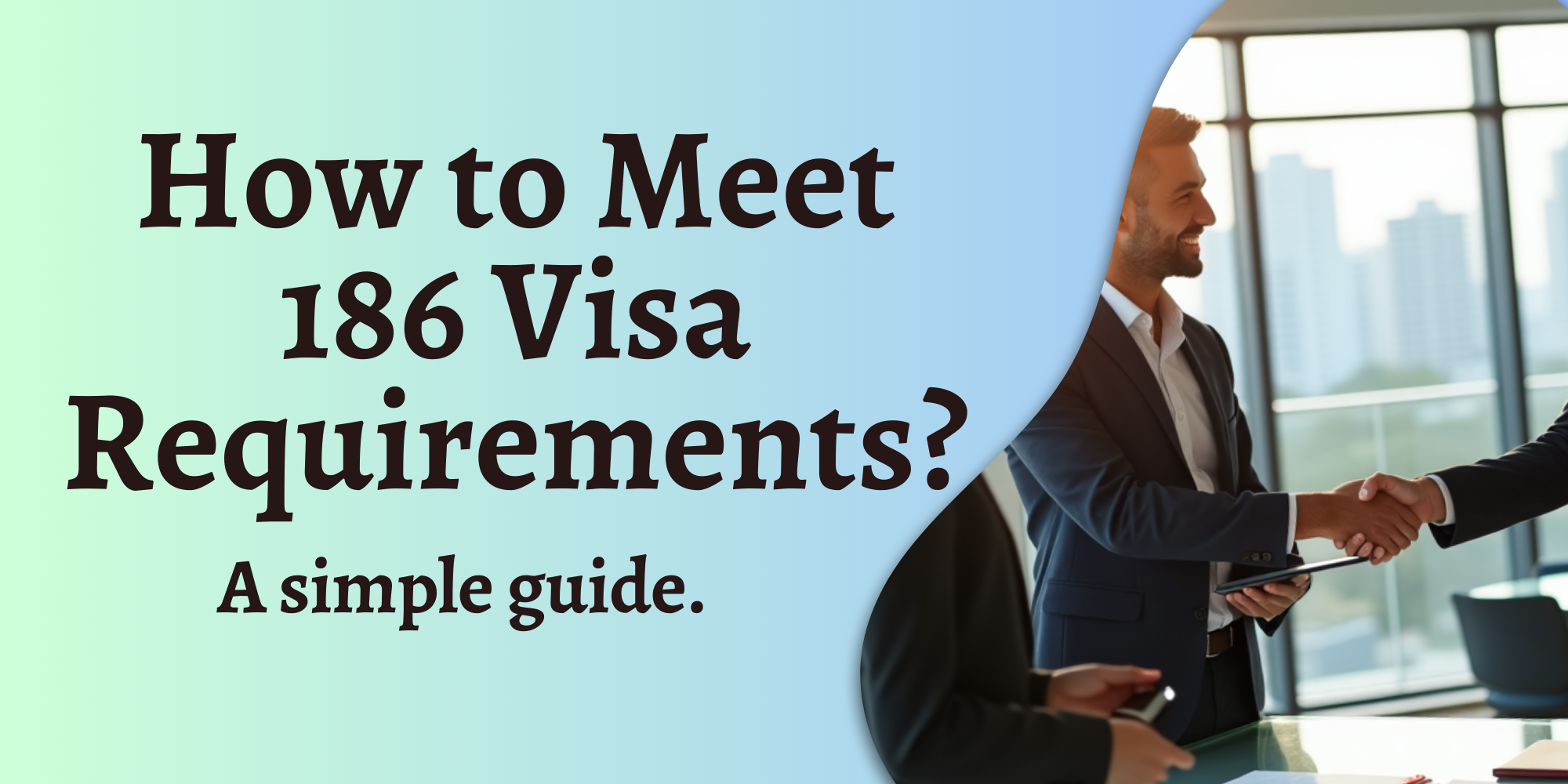What would you do if your 186 visa application could be approved in just 2 months instead of waiting for 18 months?
Many skilled workers dream of calling Australia home, yet the waiting game for permanent residency often feels like solving a puzzle. The good news? Your choice of visa stream and understanding of requirements can speed up your application significantly. Take the 186 Temporary Residence Transition stream; recent changes mean 90% of applications now reach completion within 11 months.
Are you an employer ready to sponsor talented professionals? Or perhaps you’re a skilled worker looking to make Australia your permanent home? This straightforward guide breaks down the updated requirements for the 186 visa into clear, actionable steps. Let’s help you turn your Australian dream into reality.
186 Visa Basic Requirements
Ready to start your 186 visa journey? Three key elements will shape your application success: your age, skills, and English language abilities. Let’s explore what you need to qualify.
Age and Skills Requirements
Your age matters—you’ll need to be under 45 years old when you lodge your application. Your skills matter too. Before applying, secure a valid skills assessment for your nominated occupation. This assessment stays valid until its expiry date, or three years if no expiry date is listed. Remember, you must complete your skills assessment before submitting your visa application. Any assessment obtained after submission won’t meet visa requirements.
English Language Proficiency
Show your English language skills through either:
- Your passport—if you’re from the UK, USA, Canada, New Zealand, or Republic of Ireland
- English test scores that meet these minimum requirements:
- IELTS: Score 6 in each test component
- TOEFL iBT: Listening 12, Reading 13, Writing 21, Speaking 18
- PTE Academic: 50 in each component
- OET: B grade in each component
- Cambridge C1 Advanced: 169 in each component
Work Experience Needed
Your work history plays a crucial role. You’ll need three years of full-time work experience in your nominated occupation. What counts as full-time? Think 38 hours each week. Working part-time? No worries—we’ll calculate it proportionally. For example, six months of part-time work counts as three months of full-time experience. Keep in mind that career breaks, unemployment periods, or extended unpaid leave won’t count towards your experience.

Choose Your Visa Stream
Picture three different doors to your Australian permanent residency—each designed for different situations and timelines. Which door suits you best? Let’s explore your options.
Direct Entry Stream Overview
Fresh to the Australian workforce? The 186 Direct Entry stream might be your perfect match. You’ll need a skills assessment and three years of work experience in your nominated occupation. The waiting game? Quite reasonable—25% of applicants hear back within 4 months and 90% within 13 months.
Temporary Residence Transition Path
Good news for temporary residents! The 186 TRT stream just became more welcoming. Gone are the days of sticking with one sponsor—now you can mix and match experience from different approved employers. Better yet, you’ll only need two years of work experience within a three-year window. Most applicants (75%) receive their outcome within 11 months.
Labour Agreement Options
Sometimes, the usual rules don’t quite fit. That’s where labour agreements shine. This pathway welcomes:
- Professionals with occupations outside the Medium to Long Term Skills Shortage List
- Applicants who’ve celebrated their 45th birthday
- Those still working on their English skills
Quick processing is a bonus here—half of all applications wrap up within 7 months and 90% within 11 months. This flexible route proves especially valuable when employers need specific skills that don’t fit the standard visa box.
Prepare Your Documentation
Picture yourself at the final stage of your visa journey, only to realise a crucial document is missing. Let’s prevent that scenario by mastering your documentation requirements right now.
Personal Identity Documents
Think of your identity documents as your passport to success—quite literally! Start with your valid passport, then add your national identity card and birth certificate. Changed your name or married recently? Those certificates need to join your collection too. Family members coming along? They’ll need proper proof of their relationship to you through marriage or birth certificates.
Professional Certificates
Your professional story needs solid proof. Here’s your essential checklist:
- Your career journey—a detailed CV spanning at least five years
- Academic achievements: degree certificates and transcripts (with official translations)
- Professional credentials—licences and registrations for your specific role
- Work history proof: detailed reference letters from employers
- Money matters: PAYG statements and payslips (Direct Entry stream)
Remember, honesty is non-negotiable. False documents aren’t just rejected; they’re considered a criminal offence in Australia. Some roles might ask for extra paperwork, like special licences or registrations.
Direct Entry applicants, pay special attention—your positive skills assessment could make or break your application. Want to strengthen your case? Add supporting documents like utility bills, detailed work records, and educational certificates.
Here’s a pro tip: start your document hunt early. Those overseas certificates can take ages to arrive. While you gather everything, double-check that each document meets the department’s standards. Need translations? Make sure they’re properly certified.
Complete Health and Character Checks
Ready for the final hurdles of your visa journey? Health and character checks serve as your gateway to Australia’s immigration standards. These crucial steps help maintain Australia’s robust public health system and community safety.
Medical Examination Process
Your medical journey starts with a unique HAP ID from the Department of Home Affairs. Where should you go? If you’re already in Australia, Bupa Medical Visa Services stands ready to help. Outside Australia? Local panel physicians will guide you through the process.
Your health check-up includes:
- Chest X-ray screening
- Full medical examination
- HIV testing (for those 15 and above)
- Extra screenings for healthcare workers (Hepatitis B and C)
Don’t forget your essentials on examination day—a valid passport, glasses if you wear them, and medical reports for any existing conditions. Your results reach the department electronically within five business days. Time matters here—you’ll have 28 days to complete these checks once they’re requested.
Police Clearance Requirements
Section 501 of the Migration Act 1958 sets clear expectations for character checks. Have you lived overseas? You’ll need police certificates from any country where you’ve spent 12 months or more in the past ten years. These certificates stay valid for 12 months after issue.
The department needs you to:
- Tell them about any pending criminal charges
- Share details of convictions from any country
- Submit Form 80 Personal Particulars when asked
- Include military certificates if relevant
Little ones under 16 typically skip police checks unless specifically asked. Here’s the bottom line: honesty is your best policy. The Department can refuse or cancel visas for those who fall short of character requirements.
Securing Your Future in Australia with the 186 Visa
Picture yourself holding your permanent residency visa, knowing you’ve successfully navigated the 186 visa journey. Sound impossible? Let’s put those worries to rest.
The path to success starts with mastering the core requirements. Your age, skills assessment, English abilities, and work experience create the foundation of your application. Think of these elements as puzzle pieces—when they fit perfectly, your application shines.
Which pathway suits your story best? The Direct Entry stream welcomes newcomers to Australian shores, while the Temporary Residence Transition path rewards those already contributing to Australian workplaces. Need something different? Labour agreements offer a helping hand when standard routes don’t quite match your situation.
Your visa success story depends on careful planning. Start early—gather those important documents, schedule your medical checks, and request police certificates from your previous home countries. Think of it as building your future, one document at a time.
Processing times might vary, but recent changes have opened more doors than ever before. Your key to success? Double-check every requirement before you click that submit button. Only speak with knowledgeable and registered migration professionals and lawyers like KBA Global. After all, your Australian dream deserves the best possible chance of becoming reality so make sure its secure.

